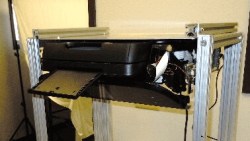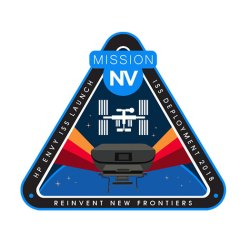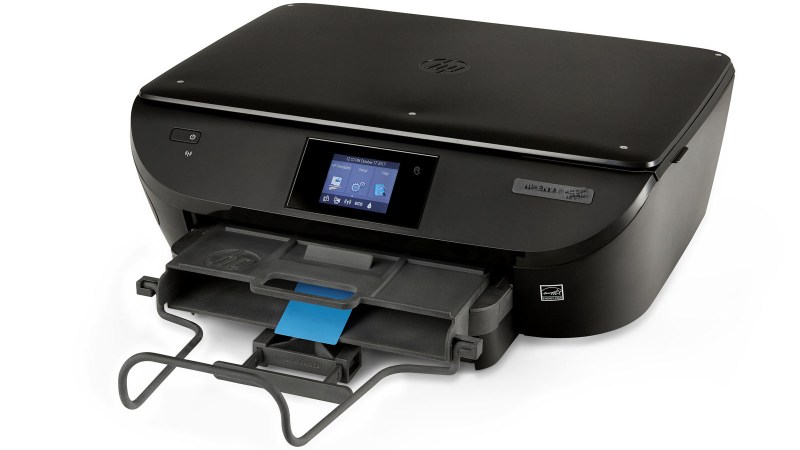The International Space Station is one of our leading frontiers of science and engineering, but it’s easy to forget that an exotic orbiting laboratory has basic needs shared with every terrestrial workplace. This includes humble office equipment like a printer. (The ink-on-paper kind.) And if you thought your office IT is slow to update their list of approved equipment, consider the standard issue NASA space printer draws from a stock of modified Epson Stylus 800s first flown on a space shuttle almost twenty years ago. HP signed on to provide a replacement, partnering with Simplexity who outlined their work as a case study upgrading HP’s OfficeJet 5740 design into the HP Envy ISS.

Simplexity provided more engineering detail than HP’s less technical page. Core parts of inkjet printing are already well suited for space and required no modification. Their low power consumption is valued when all power comes from solar panels, and ink flow is already controlled via methods independent of gravity. Most of the engineering work focused on paper handling in zero gravity, similar to the work necessary for its Epson predecessor. To verify gravity-independent operation on earth, Simplexity started by mounting their test units upside-down and worked their way up to testing in the cabin of an aircraft in free fall.
CollectSpace has a writeup with details outside Simplexity’s scope, covering why ISS needs a printer plus additional modifications made in the interest of crew safety. Standard injection-molded plastic parts were remade with an even more fire-resistant formulation of plastic. The fax/scanner portion of the device was removed due to concerns around its glass bed. Absorbent mats were attached inside the printer to catch any stray ink droplets.
 NASA commissioned a production run for 50 printers, the first of which was delivered by SpaceX last week on board their CRS-14 mission. When it wears out, a future resupply mission will deliver its replacement drawn from this stock of space printers. Maybe a new inkjet printer isn’t as exciting as 3D printing in space or exploring space debris cleanup, but it’s still a part of keeping our orbital laboratory running.
NASA commissioned a production run for 50 printers, the first of which was delivered by SpaceX last week on board their CRS-14 mission. When it wears out, a future resupply mission will deliver its replacement drawn from this stock of space printers. Maybe a new inkjet printer isn’t as exciting as 3D printing in space or exploring space debris cleanup, but it’s still a part of keeping our orbital laboratory running.
[via Engadget]
















Ink cartridges are expensive enough for us civilians. I can imagine the reaming NASA is gonna get for this one.
Isn’t it basically jetting ink everywhere if it is printing in microgravity? How directed are the jets in practice? Do they splash out any after impacting or hold together due to cohesive forces being stronger in such an environment? Interesting to see how that would all work in practice in space.
Also curious to know what the ink jets refills cost.
From what I understand they are actually quite directional from the jets. In fact, a recent article has a video which is interesting for just observation, about how far away it is, with no spatter. https://hackaday.com/2018/03/20/repurposing-inkjet-technology-for-3d-printing/
Sure but what you don’t see there is a close up view nor are you looking at small amounts of ink that might be released but immediately strike the paper, rather than float around. Also, that is being done in a normal gravity environment. Plenty of things behave significantly differently when in microgravity and I freely admit to not having studied the details of this at all.
They typically heat minuscule quantities of the ink to roughly three times the temperature of the surface of the sun and that provides the energy which launches it towards the paper.
If each ISS comes with a starter cartridge it might just be cheaper to replace the whole station.
That’s why I got a laser printer
While I was expecting jokes about the cost of cartridges in the comments, yours still made me laugh.
Only Genuine™ stations can be used, and they’ll be chipped to ensure that.
ROFL!
Wouldn’t it have somehow been smarter to declare the orbital environment off limits to dead-tree paperwork? Putting a printer up there is just begging for NASA’s legendary bureaucracy to turn it into a paper-packed fiasco. In triplicate. That will get lost between there and the office which demands it.
What do you do when you need emergency procedures to bring the power systems back online, when there is a fault.
E-ink with back-light.
How are you printing with the power offline?
You’re printing updated emergency procedures beforehand and reading them with a flashlight when the power is offline.
If you follow the link to the CollectSpace writeup, it goes into more detail why paper printing still has a place in space. From the technical (print updated emergency procedures) to the humanizing (print latest pictures of family and home.)
I have a similar model printer, just got it, works great, as long as your paper is not over like 32 weight, anything thicker its fkin worthless, the only reason I did not return it was cause the window had closed on amazon
great its been modded for crew safety but cant print a thin cardstock
Well, at least SpaceX can make a few bucks putting the worlds most expensive liquid into orbit, making it even more expensive. Plus, it’s an HP. I guess when it jams they can just send up another one.
I would love to see the actual price for a cartridge that they pay.
And I’m sure I would not feel so bad.
I have 3 no 4 laser printers and one inkjet for color. The inkjet is killing me.
The kids need color for school.
I do have a color laser but $160 a cartridge is to much to replace. And I know it is way cheaper then Inkjet.
BUT my wife will not let me get the laser cartridges. Have to do what the bos says…
Remember the photo of a lightly scorched bag recovered from the Columbia debris? It was labeled color inkjet printer. I wondered if the printer had survived in operable condition – and I wanted one of those bags. Had to be super tough to survive.
I’m looking forward to when they test it in the Neutral Buoyancy Lab, that giant swimming pool where they simulate zero gravity. If it passes that test, I’d consider it spaceworthy. Or demonically possessed. Or both.
There are days (occurring more and more) when I’d like to launch my old HP inkjet printer into orbit. Got to get my old LaserJet 4 repaired soon.
Don’t bother with the old LJ4. They were tanks, true. But check out any of the cheap Brother lasers. I got mine free in 2010 or so. It was going to be thrown away because its owner bought a new one. Apparently the price difference between a new printer and an OEM drum for this printer wasn’t much. I reset the drum counter, printed with it for several years until the print quality was so bad I couldn’t take it. Then I replaced the drum. I just printed with it about 2 minutes ago. Toner is cheap for it (I think I paid $20 for TWO 2500 page refilled toners a couple of years ago) and it just won’t die.
I may go this route myself. Got my parents a cheap Brother color laser recently as a disposable printer (got tired of fighting their HP Colorjet, and a figure that if the starter toner carts and the printer itself outlive my parents, it was worth the cost).
the last time i touched an HP inkjet printer, i threw it on the ground and ordered a brother laser with wifi and copier. Actually the last time i touched it was picking up the pieces off the ground and putting it where it will sit until i turn it and some more old inkjets into a third-world 3D printer or something that doesn’t complain about being out of ink and refuse to work, yet can print a test page just fine. and for color, I got a brother color laser with wifi and no scanner. upfront cost might be a little high(but not really, considering I saw inkjet printers that cost just as much or more), but inkjet printers shorten our lifespans by adding unnecessary stress, and it doesn’t take many inkjet refills to pay for the cost of a laser printer, especially the ~$50 non-wifi, non-copier Brother (HL-L2320D) although i’d suggest going for a model with at least wifi, due to not being restricted to tethering it to a computer for functionality. I read laser printers are bad for us too, putting carcinogenic particulates in the air or something. still waiting for INKLESS® to release a product. doesn’t seem like it’d be that hard to make one, but I bet they will be expensive. seems like it’d be the proper type of printer to use in space, for monochrome, at least, due to weight restraints. should be just a CNC laser cutter that burns at low power settings and high resolution
Hope they have a good broadband link to ISS so they can download the right drivers along with all those essential 200MB of photo apps and nonsense. My HP inkjet printer lasted six months. 5.9 months trying to get a driver that worked, and 0.1 month converting it to a stand for the Samsung printer that worked perfectly right out of the box.
Why are they using a printer/scanner combo, then removing the scanner part? Why not just use a printer?